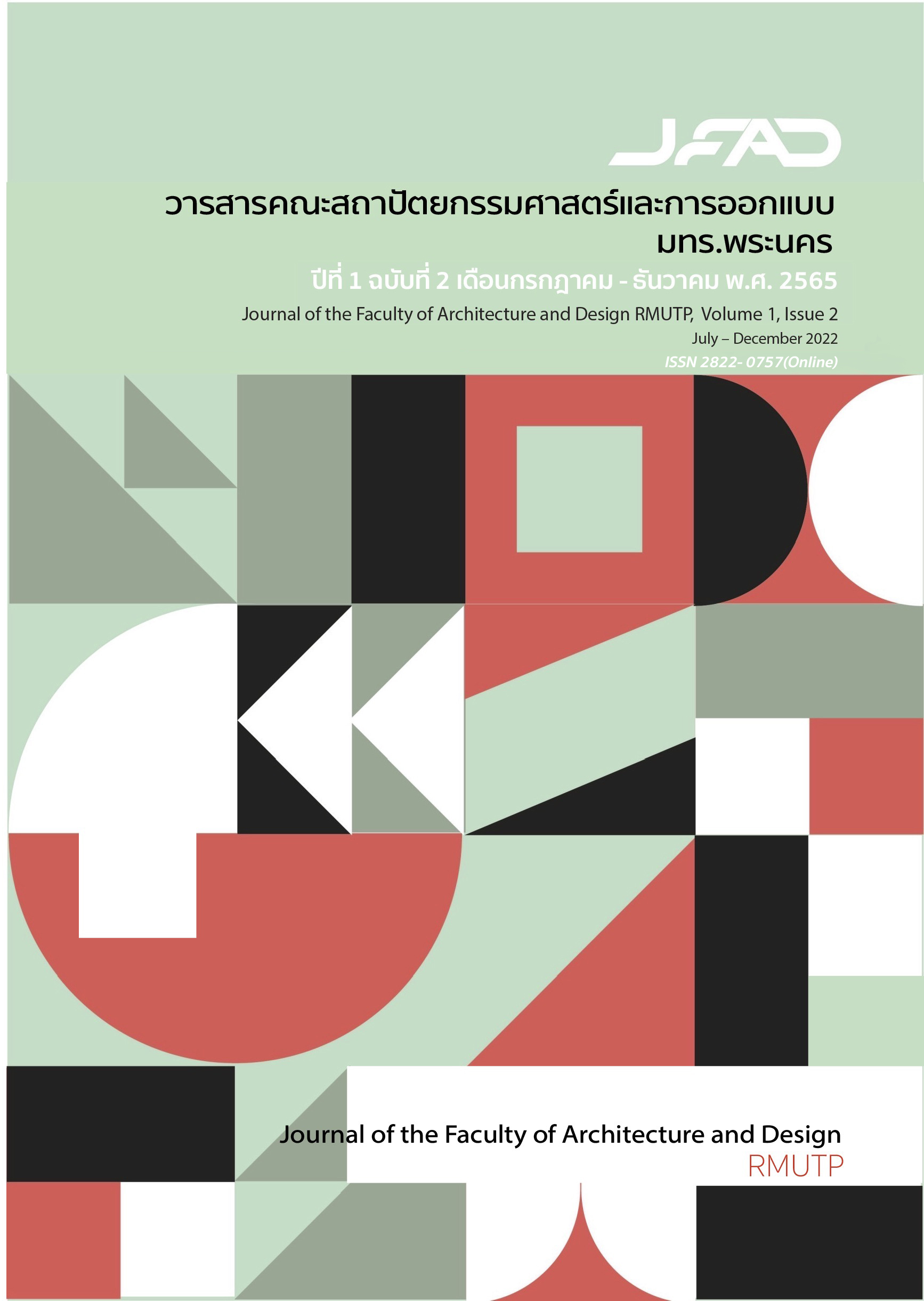Knowledge integration: Creative Industrial Product Design
Main Article Content
Abstract
Knowledge that is diverse in the present and future eras. It can be viewed as a problem in the form of trivial things in terms of knowledge that is useful in enhancing skills in creating industrial products to become intellectual skills and practical skills within the learners. This academic article is regarded as an additional lesson that assists in demonstrating integration in the form of bringing knowledge that is invaluable to product design students in order for these knowledges to be applied. The design of industrial products to meet the needs of human beings in the present and future generations is considered to be more complex as the days pass than in the past. This is considered to be the effect caused by the fluctuations in the circumstances surrounding human existence in the present and future time periods. Therefore, this academic article aims to create wisdom that encourages readers to be able to keep up with situations that are made up of various intellectual elements in product design that directly and indirectly influence the industrial product design process. It wants to encourage readers to have a wide range of intellect that helps them integrate their vast knowledge into application and integration for use in the creative process. These abilities help to provide readers with a foundation of intuition and practice in responding to human needs in current and future situations.
Article Details

This work is licensed under a Creative Commons Attribution-NonCommercial-NoDerivatives 4.0 International License.
Copyright (c) 2023 : Faculty of Architecture and Design, Rajamangala University of Technology Phra Nakhon
References
เคน เคย์. (2562). 21st Century Skill. แปลโดย วรพจน์ วงศ์กิจรุ่งเรือง. กรุงเทพฯ: บริษัท บุ๊คสเคป จำกัด.
เจมส์ บาเรนกา และรอน เบรนด์. (2562). ทักษะแห่งอนาคตใหม่ การศึกษาเพื่อศตวรรษที่ 21. แปลโดย วรพจน์ วงษ์กิจรุ่งเรือง. กรุงเทพฯ: สำนักพิมพ์บุ๊คสเคป.
อดัม แกรนต์. (2558). ออริจินอลส์ เพราะความเหมือนไม่เคยเปลี่ยนโลก. แปลโดย วิโรจน์ ภัทรทีปกร. กรุงเทพฯ: สำนักพิมพ์วีเลิร์น.
Børte, K., Nesje, K. & Lillejord, S. (2020). Barriers to student active learning in higher education, Teaching in Higher Education https://doi.org/10.1080/13562517.2020.1839746
Barnabè, F. & Nazir, S. (2022). Conceptualizing and enabling circular economy through integrated thinking. Corporate Social Responsibility and Environmental Management, 29(2), 448-468. https://doi.org/10.1002/csr.2211
Busco, C., Granà, F., & Quattrone, P. (2017). Integrated Thinking. CIMA Research Executive Summary, 13(3), Chartered Institute of Management Accountants.
Egan, A., Maguire. R., Christophers, L. & Rooney, B. (2017). Developing creativity in higher education for 21st century learners: A protocol for a scoping review. International Journal of Educational Research, 82, 21-27. https://doi.org/10.1016/j.ijer.2016.12.004
Giacomazzi, M., Fontana, M. & Trujillo, C. C. (2022). Contextualization of critical thinking in sub-Saharan Africa: A systematic integrative review. Thinking Skills and Creativity, 43, 100978. https://doi.org/10.1016/j.tsc.2021.100978
González-Pérez, L. I. & Ramírez-Montoya, M. S. (2022). Components of Education 4.0 in 21st Century Skills Frameworks: Systematic Review, Sustainability, 14(1): 1493.
Grossmann, I. (2017). Wisdom in Context. Perspectives on Psychological Science, 12(2), 233–257. https://doi.org/10.1177/1745691616672066
Hamzah, H., Hamzah, M. I. & Zulkifli, H. (2022). Systematic Literature Review on the Elements of Metacognition-Based Higher Order Thinking Skills (HOTS) Teaching and Learning Modules. Sustainability, 14(2), 813, https://doi.org/10.3390/su14020813
Hargreaves, M. B. & Podems, D. (2012). Advancing Systems Thinking in Evaluation: A Review of Four Publications. American Journal of Evaluation, 33(3), 462–470. https://doi.org/10.1177/1098214011435409
Hartikainen. S., Rintala, H., Pylväs, L. & Nokelainen, P. (2019). The Concept of Active Learning and the Measurement of Learning Outcomes: A Review of Research in Engineering Higher Education. Education Sciences, 9(4), 276 https://doi.org/10.3390/educsci9040276
Kallio, E. (2011). Integrative thinking is the key: An evaluation of current research into the development of adult thinking. Theory & Psychology, 21(6), 785–801. https://doi.org/10.1177/0959354310388344
Koh, J. H. L., Chai, C. S., Wong, B. & Hong, H. Y. (2015). Design Thinking and 21st Century Skills. In: Design Thinking for Education. Singapore: Springer.
Livingston, L. (2010). Teaching Creativity in Higher Education. Arts Education Policy Review, 111(2), 59-62, https://doi.org/10.1080/10632910903455884
Maslow, A. (1970). Human needs theory: Maslow’s hierarchy of human needs. In R.F. Craven & C. J. Hirnle (Eds.), Fundamental of Nursing: Human Health and Function. Philadelphia: Lippincott.
Maslow, A. (1970). Motivation and Personality. New York: Harpers and Row.
Miller, A. L. & Dumford, A. D. (2016). Creative Cognitive Processes in Higher Education. The Journal of Creative Behavior, 50(4), 282-293. https://doi.org/10.1002/jocb.77
Oliver, J., Vesty, G. & Brooks, A. (2016). Conceptualising integrated thinking in practice. Managerial Auditing Journal, 31(2), 228-248. https://doi.org/10.1108/MAJ-10-2015-1253
Petrova, E. (2017). The influence of positive reinforcements on motivation for education and training activities. Journal of Economic Development, Environment and People, 6(3), 6-15. https://doi.org/10.26458/jedep.v6i3.548
Ramírez-Montoya, M. S., Castillo-Martínez, I. M., Sanabria-Z. J. & Miranda, J. (2022). Complex Thinking in the Framework of Education 4.0 and Open Innovation-A Systematic Literature Review. Journal of Open Innovation: Technology, Market, and Complexity, 8(1), 4. https://doi.org/10.3390/joitmc8010004
Reaves, J. (2019). 21st-century skills and the fourth industrial revolution: a critical future role for online education. International Journal on Innovations in Online Education, 3(1): 91-99.
Sahin, M. C. (2009). Instructional design principles for 21st century learning skills. Procedia - Social and Behavioral Sciences, 1(1): 1464-1468.
Sill, D. J. (1996). Integrative Thinking, Synthesis, and Creativity in Interdisciplinary Studies. The Journal of General Education, 45(2), 129-151. https://www.jstor.org/stable/27797296
Stephen R. G. (2015). Wisdom. Australasian Journal of Philosophy, 93(1), 139-154. https://doi.org/10.1080/00048402.2014.937449
Sternberg, R. J. (1998). A Balance Theory of Wisdom. Review of General Psychology, 2(4), 347–365. https://doi.org/10.1037/1089-2680.2.4.347
Summerville, J. & Reid-Griffin, A. (2008). Technology integration and instructional design. TechTrends, 52(5): 45–51.
Ward, L. & Parr, J. M. (2010). Revisiting and reframing use: Implications for the integration of ICT. Computers & Education, 54(1): 113–122.
Wilterson, A. I. & Graziano, M. S. A. (2021). The attention schema theory in a neural networkagent: Controlling visuospatial attention using adescriptive model of attention. PNAS, 118(33), e2102421118. https://doi.org/10.1073/pnas.2102421118

